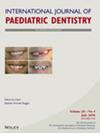口腔健康状况对镰状细胞贫血儿童和青少年生活质量的影响:横断面研究
IF 2.3
3区 医学
Q2 DENTISTRY, ORAL SURGERY & MEDICINE
引用次数: 0
摘要
背景镰状细胞性贫血(SCA)是巴西和世界上最常见的血红蛋白病,属于因血红蛋白结构异常而导致的慢性遗传病。目的评估口腔健康状况对患有 SCA 的儿童和青少年生活质量(QoL)的影响。他们的病历中必须有 HbSS SCA 诊断,且在过去三个月中没有出现过疼痛危机或任何牙科急诊,方可纳入研究。患有SCA的儿童和青少年来自马拉尼昂州的血液学和血液治疗中心。评估内容包括人口特征、社会经济状况、口腔卫生、龋齿、错牙合畸形以及与口腔健康相关的生活质量(OHRQoL)。口腔健康相关生活质量(OHRQoL)使用儿童认知问卷进行评估。研究采用了描述性统计、学生 t 检验和曼-惠特尼检验(α = 5%)。结果 两个年龄组中,棕色人种最普遍(8-10 岁-63.2%,11-14 岁-57.9%)。两个年龄组的主要家庭月收入均低于 106 美元。8-10 岁儿童的可见牙菌斑和牙龈出血量较高。龋齿通过 "口腔症状 "领域对青少年的 QoL 有明显影响(p = 0.031)。咬合不正对青少年的生活质量有明显影响("总分",p = .026;"社会福利",p = .045)。本文章由计算机程序翻译,如有差异,请以英文原文为准。
Impact of oral health conditions on the quality of life of children and adolescents with sickle cell anemia: A cross‐sectional study
BackgroundSickle cell anemia (SCA) is the most common hemoglobinopathy in Brazil and worldwide and is part of a group of chronic genetic diseases resulting from abnormalities in the structure of hemoglobin.AimTo evaluate the impact of oral health conditions on the quality of life (QoL) of children and adolescents with SCA.DesignThis is a cross‐sectional study with a sample of 76 children and adolescents aged 8–14 years. For inclusion, they were required to have a diagnosis of HbSS SCA in their medical records, without a pain crisis or any dental emergency in the last three months. The children and adolescents with SCA were from Hematology and Hemotherapy Center of Maranhão. Demographic characteristics, socioeconomic status, oral hygiene, caries, malocclusion, and oral health‐related quality of life (OHRQoL) were assessed. OHRQoL was assessed using the Child Perceptions Questionnaire. Descriptive statistics, Student's t and Mann−Whitney tests were performed (α = 5%).ResultsBrown race was the most prevalent for both age groups (8–10 years—63.2% and 11–14 years—57.9%). Predominant monthly family income for both age groups was below $106. Visible plaque and gingival bleeding were higher in children aged 8–10 years. Dental caries significantly impacted the QoL of adolescents through the domain “oral symptom” (p = .031). Malocclusion significantly impacted the QoL of adolescents (“total score,” p = .026; “social well‐being”, p = .045).ConclusionOral health impairment negatively affected the QoL of adolescents with SCA.
求助全文
通过发布文献求助,成功后即可免费获取论文全文。
去求助
来源期刊
CiteScore
5.50
自引率
2.60%
发文量
82
审稿时长
6-12 weeks
期刊介绍:
The International Journal of Paediatric Dentistry was formed in 1991 by the merger of the Journals of the International Association of Paediatric Dentistry and the British Society of Paediatric Dentistry and is published bi-monthly. It has true international scope and aims to promote the highest standard of education, practice and research in paediatric dentistry world-wide.
International Journal of Paediatric Dentistry publishes papers on all aspects of paediatric dentistry including: growth and development, behaviour management, diagnosis, prevention, restorative treatment and issue relating to medically compromised children or those with disabilities. This peer-reviewed journal features scientific articles, reviews, case reports, clinical techniques, short communications and abstracts of current paediatric dental research. Analytical studies with a scientific novelty value are preferred to descriptive studies. Case reports illustrating unusual conditions and clinically relevant observations are acceptable but must be of sufficiently high quality to be considered for publication; particularly the illustrative material must be of the highest quality.

 求助内容:
求助内容: 应助结果提醒方式:
应助结果提醒方式:


